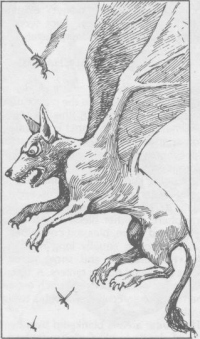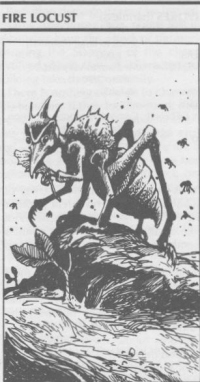|
 The gwerrah is a quadruped that roams freely about the plains, forests and moraines. No creatures native to Alcazzar are capable of threatening it. It's legs are short and it's body is quite stocky. Averaging 10 metres long, 4 metres high and 3 metres wide, the gwerrah towers over all other animals on Alcazzar. It is coveres with coarse black hair, except for it's eyes and nose. The eys of a gwerrah are incredibly keen and mounted on the top of it's head so it can see for great distances. The gwerrah possess almost no hearing and a very limited sense of smell, however. The gwerrah is a quadruped that roams freely about the plains, forests and moraines. No creatures native to Alcazzar are capable of threatening it. It's legs are short and it's body is quite stocky. Averaging 10 metres long, 4 metres high and 3 metres wide, the gwerrah towers over all other animals on Alcazzar. It is coveres with coarse black hair, except for it's eyes and nose. The eys of a gwerrah are incredibly keen and mounted on the top of it's head so it can see for great distances. The gwerrah possess almost no hearing and a very limited sense of smell, however.The gwerrah has adapted to Alcazzar's severe winters by going into deep hibernation, usually in a cave or niche in some rocks. During the time it is active the gwerrah is incredibly voracious, eating any form of meat available, as well as tons of karakah fruit. The gwerrah preys upon any creatures that do not get out of it's path in time. |
|||||||||||||||||||||||
|
 Sky-shrikes are among the most voracious carnivores in the known galaxy. Wheeling through the skies of Alcazzar in great, hungry packs, they are always alert for movement on the ground. Resembling large, savage dogs with wings, they eat any kind of meat or carrion. Their leathery wings often span 3 metres. Sky-shrikes are among the most voracious carnivores in the known galaxy. Wheeling through the skies of Alcazzar in great, hungry packs, they are always alert for movement on the ground. Resembling large, savage dogs with wings, they eat any kind of meat or carrion. Their leathery wings often span 3 metres.Packs range up to 100 creatures in size, but they do not all fly together. Generally half the pack circles in one central group whil the other half is dispersed over a radius of 10-15 kilometres, seraching for food. When one of the scouts spots potential prey, it reverses the direction of it's circling from clockwise to counterclockwise (as viewed from the ground). The others race to the scene, and when the whole pack is assembled they drop to attack. Only if the potential prey is about to reach the trees or rocks do the sky-shrikes on the scene attack early. Usually their patience is extraordinary. Sky-shrikes attack by diving at their prey, slashing with their razor-sharp teeth and quickly climbing away. Thus trees and jutting rocks provide good protection from their attacks. Pity the poor creature discovered on the open plains or mudflats by a pack of sky-shrikes. |
|||||||||||||||||||||||
|
 These clever primates are the most intelligent natives of Alcazzar. They are found throughout the planet's fertile belt. Their appearanc e varies depending on the season. In spring, they emerge from a long hibernation wit loose baggy skin and hair falling off in great patches. By autumn their hair has grown back to full, bristly coats, and their bodies have become plump in preparation for hibernation. Lokkuku have flat, monkey-like faces, but no tails. The colour of their fur varies from individual to individual, but it usually some shade of brown. These clever primates are the most intelligent natives of Alcazzar. They are found throughout the planet's fertile belt. Their appearanc e varies depending on the season. In spring, they emerge from a long hibernation wit loose baggy skin and hair falling off in great patches. By autumn their hair has grown back to full, bristly coats, and their bodies have become plump in preparation for hibernation. Lokkuku have flat, monkey-like faces, but no tails. The colour of their fur varies from individual to individual, but it usually some shade of brown.Lokkuku live in tribes of up to 50 individuals, always ruled by a dominant male. They have learned to use clubs and vines as weapons and work together to hunt. Tribes live in the hollowed bases of karakah trees. Air holes, 20 or 30 metres up, let in fresh air during their winter hibernation. Lokkuku resolve disputes over territory and food supplies with a system of warefare. Even though their weapons are primitive speasr, lokkuku fight with great skill and savagery; many die in their wars. Lokkuku are very curious. They do not attack new animals on sight, preferring to watch and see what develops. If treated to a display of "magic" (i.e. flashy technology), they may even adopt an attitude of reverence toward the strangers. Of course, if any lokkuku are harmed, their vengeance is swift and merciless. Perhaps the most bizarre aspect of lokkuku life is the ceremony of the "Kag-Gakka", a ritual party centred around highly fermented karakah fruit. The primates have found that when they harvest the fruit and store it in a dark place, it ferments into alcohol. To them the fruit takes on "magical" properties. During the Kag-Gakka, an entire tribe gathers around the overripe fruit, pulling out and eating great fist fulls of pulp, until the situation is totally out of control. Lokkuku are capable of extreme violence or extreme affection at these times. Characters who try the fruit become violently ill for 1d10 hours). |
|||||||||||||||||||||||
|
 Fire locusts are large, hoping insects that screte an extremely destructive acid. They travel over Alcazzar in huge chittering packs, clearing a swath up to 1 kilometre wide. Although they eat plants, any animal caught in their path face certain death unless somehow protected from the ravaging horde. Fire locusts are large, hoping insects that screte an extremely destructive acid. They travel over Alcazzar in huge chittering packs, clearing a swath up to 1 kilometre wide. Although they eat plants, any animal caught in their path face certain death unless somehow protected from the ravaging horde.The acid secreted by Fire Locusts is so caustic that it burns any non-metallic material it contacts. Although the damge from one locust's burn equals only a fraction of a stamina point, the number of locusts in a swarm cause the listed damage to any creature not protected against the acid. The are only two to three hordes of fire locusts swarming across Alcazzar at any one time. Despite their relative infrequency, the destructive potential of these bugs makes them a threat to all animals and most activities on the planet. |
|||||||||||||||||||||||
|
 Breeds of this monstrous fish thrive in both freah and salt wate. The adult ranges in length from 5 to more than 10 metres. This carnivorous beast is not a scavengar, but eats nearly anything that moves through the water. Small fish are the staple of the sea-shrikes diet, but any unfortunate mammals that happen to enter the water may also be eaten. Breeds of this monstrous fish thrive in both freah and salt wate. The adult ranges in length from 5 to more than 10 metres. This carnivorous beast is not a scavengar, but eats nearly anything that moves through the water. Small fish are the staple of the sea-shrikes diet, but any unfortunate mammals that happen to enter the water may also be eaten.The sea-shrike attacks a creature (or vehicle) on the surface of the water by jumping upward from the depths. In the first round it bites. In the next round it tries to hit it's victim with it's tail as it turns to dive again. If the tail hits a creature, that creature must make a succesful Stamina check or be stunned for 1-10 turns. If a vehicle is struck, roll on the Vehuicle Damage Table. After the first two-round attack, the sea-shrike dives and circles, coming up and repeating it's attack 5-10 rounds later. Any creature (not vehicle) bitten by a sea-shrike with an attack roll of 10 or less, is caught in the sea-shrike's mouth and carried to the bottom. The sea-shrike does not attack as long as it holds a victim in it's mouth. To escape the captured creature must break a wrestling hold with a -30 modifier. |
|||||||||||||||||||||||
|
 The snow sloth is the only animal known to prowl the snow fields during Alcazzar's winter. Growing up to 5 metres long, the sloth resembles a huge weasel with coarse white hair and stocky legs. Although not a fast runner, the sloth can lope for days at a time across snow, supported by it's huge padded feet. The snow sloth is the only animal known to prowl the snow fields during Alcazzar's winter. Growing up to 5 metres long, the sloth resembles a huge weasel with coarse white hair and stocky legs. Although not a fast runner, the sloth can lope for days at a time across snow, supported by it's huge padded feet.If the snow sloth strikes a victim with an attack roll lower than 20, the victim is held and squeezed. Each successive round the character takes 5d10 points of damage automatically until killed, or until the character successfully breaks a wrestling hold. The snow sloth lives primarily by eating hibernating lokkuku. It finds a tree where a tribe is spending winter, breakes through an airhole and slithers down for a feast. In their lethargic state, the lokkuku can rarely arouse themselves to fight, but if they do, the snow sloth is usually driven off. |
|||||||||||||||||||||||
|
|
|||||||||||||||||||||||
|
Subsisting on leaves and grasses, the gnawhare is no threat to animals, but it's large teeth make it dangerous to inanimate objects that it might line it's nest with. The gnawhare is possessed with an overwhelming curiosity and is always looking for something new and unusual to carry off. It will chew off a piece of anything that is too big to carry, and haul the piece back to it's burrow. Rubber. fabrics and soft plastics are all materials the gnawhare will use to coat it's nest. If the PC's encounter these creatures, the gnawhares will attempt to chew up a piece of equipment made of rubber, fabris or soft plastic. PC's will not encounter gnawhares while travelling. However, given enough time, gnawhares are fully capable of disabling a stopped vehicle. |
|||||||||||||||||||||||
|
These animals either migrate (the most common technique) or hibernate to survive the winter. Great herds have worn regular paths around the planet by following the same route each year. Naturally the palnets carinvore's follow these paths for the plentiful food they offer. Many of Alcazzar's herbivores are edible by the four races. Those that are not edible are not poisonous, simply bad tasting. |
|||||||||||||||||||||||
|
Many insects look grotesque by most standards, with bulging eyes and thick furry bodies. None would be considered edible except under the most dire circumsctances. |
Star Frontiers (tm), the setting, and any published material and images from the rules are all copyrights and trademarks of TSR, Inc., and appear here only for private informational and/or educational purposes. All other materials are the property of their authors.